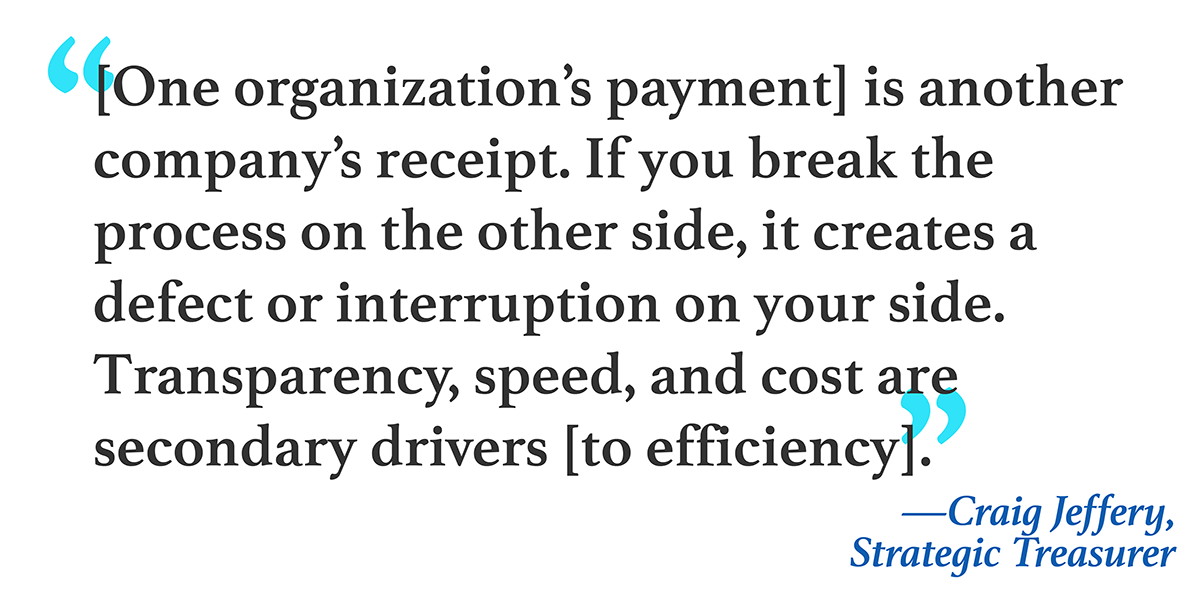"Banks and startups alike are investing a lot of time and money [into] rethinking payments services and infrastructure, in an effort to improve the efficiency and speed of the network," says Corning Inc. director of liquidity and investment management Stephen Fowler. "Real-time payments offer companies the opportunity to process and receive payments 'just in time' and outside of normal payment windows, potentially driving savings on the float."
Strategic Treasurer managing partner Craig Jeffery describes payments as "an area of extensive focus by nearly everyone in the ecosystem, for a variety of reasons. There are more payments each year, and the newer payment platforms are growing and increasing their limits." The National Automated Clearing House Association (NACHA) recently upped same-day ACH limits to $1 million per transaction, and The Clearing House's RTP [real-time payment] network soon followed suit.
Meanwhile, more and more countries and businesses are rolling out use cases for real-time payments. The U.S.'s FedNow service, which will support account-to-account and consumer-to-business bill-pay use cases, is slated to come online in 2023. Its objective, according to Ernst & Young senior manager Gaurav Kohli, is to enable financial institutions of every size to provide safe and efficient instant payment services on a 24×7×365 basis. At the same time, an assortment of private firms are developing tokenization, distributed ledger technologies, and cryptocurrencies that can facilitate the processes needed to underpin same-day payments.
As treasury groups evaluate whether and how to leverage these and other emerging payment solutions, they should make sure to consider the effects on:
Financial controls. Organizations should maintain a complete inventory of every payment process they use, from initiation through settlement. "The process must be mapped for security and exposures," says Jeffery, who notes that many companies fail to maintain sufficient information about their payment methods. "Compensating controls need to be added, where appropriate, until the underlying issues can be fixed." If an organization cannot map and mitigate security risks and other exposures, Jeffery suggests, they should consider outsourcing these activities to an external payment network.
Liquidity. Real-time payments require treasury functions to ensure that the organization maintains sufficient liquidity at all hours of the day and night. "As payments can settle within seconds of being initiated," Kohli notes, "treasury needs to forecast the volume and value of instant-payment activities based on historical analysis of client activities as well as anticipated demand based on business pipeline and market drivers." Liquidity also must be available in markets where alternative funding mechanisms are not available outside normal business hours, such as on weekends and during holidays.
Supporting technology. The forecasting that Kohli recommends requires supporting technology—ideally, a payment or treasury management system with 24×7 monitoring and alerts. Joel L. Campbell, CFO of payments and invoicing network TreviPay, says that a robust treasury management system with connections to the SWIFT network is a must.
"The old means of using banking websites, while still effective, is slowly being replaced by modern technology that can automate daily processing, general ledger postings, and movement of money globally," Campbell says. "Having banking partners that support the move to more real-time payments for treasury teams is extremely important as well."
Deciding to Utilize a New Payment Method
When treasury leaders evaluate their payment options, they tend to make decisions based on speed, security, cost, and payment-size limits. Jeffery stresses that it is important to distinguish between transaction speed and efficiency—and to elevate the value of efficiency.
Treasury teams should scrutinize what Jeffery describes as the "round-trip process." Speed is only one facet of efficiency in the payment cycle; overall efficiency hinges on effective execution, as well.
Further, Jeffery adds, one organization's payment "is another company's receipt. If you break the process on the other side, it creates a defect or interruption on your side. Transparency, speed, and cost are secondary drivers [to efficiency]—important, but secondary."
See also:

- July 2022 Special Report: Cross-Border Cash Flows
- The New Normal in Liquidity Management
- Swept Away, Thanks to Rising Rates
- Optimizing Cash Requires a Remodel
- Real-Time Payments: What to Know, and What to Do
- The Future of Real-Time Global Payments
Eric Krell's work has appeared previously in Treasury & Risk, as well as Consulting Magazine. He is based in Austin, Texas.
© 2024 ALM Global, LLC, All Rights Reserved. Request academic re-use from www.copyright.com. All other uses, submit a request to [email protected]. For more information visit Asset & Logo Licensing.






